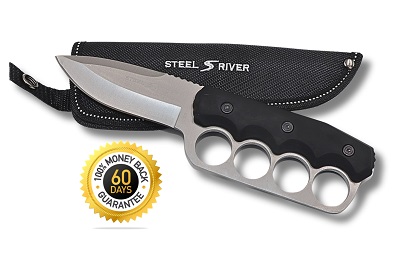

We Need Your Feedback – Get a Tactical Trench Knife FREE
We're putting our latest tactical knife to the test-and we want YOU to be one of the first to try it out. The Steel River Trench Knife is a battle-ready blade designed for those who demand strength, reliability, and control.
For a limited time, we're giving away 200 of these knives-all we ask is that you cover a small $9.95 shipping fee and let us know what you think.
This isn't some flimsy gas station knife. It's a full-tang, razor-sharp blade with a knuckle-guard grip-engineered for serious action.
3.75" Razor-Sharp Blade Full-Tang Design for Durability Knuckle Guard for a Commanding Grip Tactical Sheath Included
200 AVAILABLE – WHEN THEY'RE GONE, THEY'RE GONE!
P.S. This is a first-run production model-we want real feedback from real users like you. Don't wait-once these 200 are claimed, this offer disappears.
ted to either side of the base of the petiole) and a sheath. Not every species produces leaves with all of these structural components. The lamina is the expanded, flat component of the leaf which contains the chloroplasts. The sheath is a structure at the base that fully or partially wraps around the stem, above the node where the leaf is attached. Leaf sheathes typically occur in Poaceae (grasses), Apiaceae (umbellifers), and many palms. Between the sheath and the lamina, there may be a pseudopetiole, a petiole like structure. Pseudopetioles occur in some monocotyledons including bananas, palms and bamboos. Stipules may be conspicuous (e.g. beans and roses), soon falling or otherwise not obvious as in Moraceae or absent altogether as in the Magnoliaceae. A petiole may be absent (apetiolate), or the blade may not be laminar (flattened). The petiole mechanically links the leaf to the plant and provides the route for transfer of water and sugars to and from the leaf. The lamina is typically the location of the majority of photosynthesis. The upper (adaxial) angle between a leaf and a stem is known as the axil of the leaf. It is often the location of a bud. Structures located there are called "axillary". New pomegranate leaves External leaf characteristics, such as shape, margin, hairs, the petiole, and the presence of stipules and glands, are frequently important for identifying plants to family, genus or species levels, and botanists have developed a rich terminology for describing leaf characteristics. Leaves almost always have determinate growth. They grow to a specific pattern and shape and then stop. Other plant parts like stems or roots have non-determinate growth, and will usually continue to grow as long as they have the resources to do so. A leaf shed in autumn The type of leaf is usually characteristic of a species (monomorphic), although some species produce more than one type of leaf (dimorphic or polymorphic). The longest leaves are those of the Raffia palm (Raphia regalis) which may be up to 25 m (82 ft) long and 3 m (9.8 ft) wide. The termi
